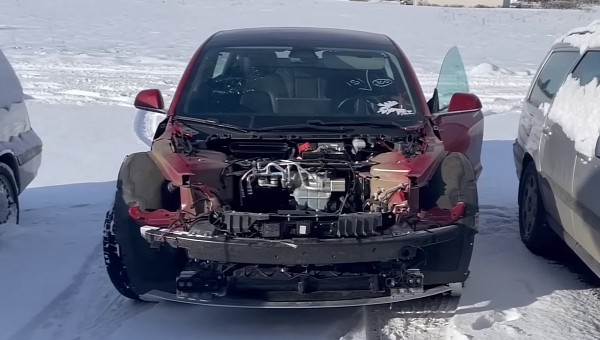A salvaged Tesla Model 3 could detect distances even after the front bumper containing the ultrasonic sensors was taken off. This finding is surprising considering that the car was running the 2022.28.2 software version released in September 2022. Tesla was said to introduce Vision distance measurement only with the 2022.40.4 software version.
Tesla surprised many people last year when it announced that, from now on, ultrasonic sensors would be deprecated, and new cars would be delivered without them. If you’re curious, ultrasonic sensors (USS) are small, round sensors in the front and rear bumpers used to detect obstacles around the car that are otherwise impossible to see from behind the steering wheel. Tesla’s decision meant losing some features like Autopark, Park Assist, and Summon functions, at least until the EV maker finds a workaround.
If you’re wondering why Tesla would give up on USS use, there could be several reasons. Tesla’s point of view is that Tesla Vision could offer similar functionality by calculating the obstacle’s position once it has “seen” it before, based on the car’s movements. Teardown expert Sandy Munro, on the other hand, thinks this is a cost-cutting measure that allows Tesla to save around $150 per vehicle. It doesn’t sound like a lot, but multiply that with the 2 million cars that Tesla thinks it might sell in 2023, and it starts to look enticing.
Not long after the announcement, Tesla hacker Green (@greentheonly) discovered an interesting addition to software version 2022.40.4. The update’s software code analysis revealed that Tesla uses Autopilot data to offer distance measurements to nearby objects on vehicles without ultrasonic sensors. It wasn’t clear at the time how the new feature worked, especially for things in blind zones around the car. Nevertheless, Tesla owner and EV mechanic Occupy Mars (@TESLA_winston) had a surprise several days ago after taking off the front bumper of a salvaged Tesla Model 3.
The car was a 2018 model, so it came with ultrasonic sensors from the factory. Nevertheless, taking off the front bumper means the sensors were also disconnected, turning the car into a USS-less Model 3. Anyway, even without the sensors, the Model 3 could still measure (and display) the distances to obstacles around it. The finding was startling, considering that the car was running an older software version from before Tesla announced giving up on USS. This confirms that Tesla was experimenting with Tesla Vision to detect nearby objects before it announced removing the ultrasonic sensors.
As expected, the Vision-led distance measurement doesn’t see objects hidden from the cameras’ field of view. Occupy Mars started experimenting by covering the front-facing and B-pillar cameras with tape. As expected, the car would lose the ability to display distances to objects and even acknowledge their presence. The mechanic went further and unplugged the radar sensor to rule out its use. Even without radar, the car could still detect objects and estimate distances.
The most probable reason for using Tesla Vision to detect objects on a car with ultrasonic sensors was that Tesla tested this feature a while back. It’s highly likely that Tesla compared the results from ultrasonic sensors and cameras and used them to calibrate Tesla Vision for distance measurements.
If you’re wondering why Tesla would give up on USS use, there could be several reasons. Tesla’s point of view is that Tesla Vision could offer similar functionality by calculating the obstacle’s position once it has “seen” it before, based on the car’s movements. Teardown expert Sandy Munro, on the other hand, thinks this is a cost-cutting measure that allows Tesla to save around $150 per vehicle. It doesn’t sound like a lot, but multiply that with the 2 million cars that Tesla thinks it might sell in 2023, and it starts to look enticing.
Not long after the announcement, Tesla hacker Green (@greentheonly) discovered an interesting addition to software version 2022.40.4. The update’s software code analysis revealed that Tesla uses Autopilot data to offer distance measurements to nearby objects on vehicles without ultrasonic sensors. It wasn’t clear at the time how the new feature worked, especially for things in blind zones around the car. Nevertheless, Tesla owner and EV mechanic Occupy Mars (@TESLA_winston) had a surprise several days ago after taking off the front bumper of a salvaged Tesla Model 3.
The car was a 2018 model, so it came with ultrasonic sensors from the factory. Nevertheless, taking off the front bumper means the sensors were also disconnected, turning the car into a USS-less Model 3. Anyway, even without the sensors, the Model 3 could still measure (and display) the distances to obstacles around it. The finding was startling, considering that the car was running an older software version from before Tesla announced giving up on USS. This confirms that Tesla was experimenting with Tesla Vision to detect nearby objects before it announced removing the ultrasonic sensors.
As expected, the Vision-led distance measurement doesn’t see objects hidden from the cameras’ field of view. Occupy Mars started experimenting by covering the front-facing and B-pillar cameras with tape. As expected, the car would lose the ability to display distances to objects and even acknowledge their presence. The mechanic went further and unplugged the radar sensor to rule out its use. Even without radar, the car could still detect objects and estimate distances.
The most probable reason for using Tesla Vision to detect objects on a car with ultrasonic sensors was that Tesla tested this feature a while back. It’s highly likely that Tesla compared the results from ultrasonic sensors and cameras and used them to calibrate Tesla Vision for distance measurements.








